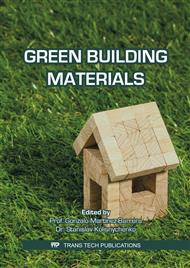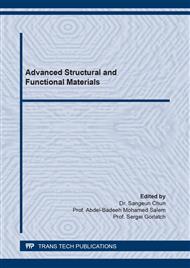[1]
Hsu, E., Barmak, K., West, A. C., & Park, A. H. A. (2019). Advancements in the treatment and processing of electronic waste with sustainability: a review of metal extraction and recovery technologies. Green Chemistry, 21(5), 919-936.
DOI: 10.1039/c8gc03688h
Google Scholar
[2]
Islam, M. K., Wang, H., Rehman, S., Dong, C., Hsu, H. Y., Lin, C. S. K., & Leu, S. Y. (2020). Sustainability metrics of pretreatment processes in a waste derived lignocellulosic biomass biorefinery. Bioresource Technology, 298, 122558.
DOI: 10.1016/j.biortech.2019.122558
Google Scholar
[3]
Pierroni, X. (2019). E-WASTE AND SUSTAINABILITY IN A CHANGING ENVIRONMENT. Sustainable Economy and Emerging Markets.
Google Scholar
[4]
Agovino, M., Cerciello, M., & Musella, G. (2019). The good and the bad: identifying homogeneous groups of municipalities in terms of separate waste collection determinants in Italy. Ecological Indicators, 98, 297-309.
DOI: 10.1016/j.ecolind.2018.11.003
Google Scholar
[5]
Blengini, G. A. (2009). Life cycle of buildings, demolition and recycling potential: A case study in Turin, Italy. Building and environment, 44(2), 319-330.
DOI: 10.1016/j.buildenv.2008.03.007
Google Scholar
[6]
Thormark, C. (2006). The effect of material choice on the total energy need and recycling potential of a building. Building and environment, 41(8), 1019-1026.
DOI: 10.1016/j.buildenv.2005.04.026
Google Scholar
[7]
Iannace, G., Ciaburro, G., Guerriero, L., & Trematerra, A. (2020). USE OF CORK SHEETS FOR ROOM ACOUSTIC CORRECTION. Journal of Green Building, 15(2), 45-55.
DOI: 10.3992/1943-4618.15.2.45
Google Scholar
[8]
Amares, S., Sujatmika, E., Hong, T. W., Durairaj, R., & Hamid, H. S. H. B. (2017, October). A review: characteristics of noise absorption material. In Journal of Physics: Conference Series (Vol. 908, No. 1, p.012005). IOP Publishing.
DOI: 10.1088/1742-6596/908/1/012005
Google Scholar
[9]
Iannace, G., Ciaburro, G., & Trematerra, A. (2020). Modelling sound absorption properties of broom fibers using artificial neural networks. Applied Acoustics, 163, 107239.
DOI: 10.1016/j.apacoust.2020.107239
Google Scholar
[10]
Ciaburro, G., Iannace, G., Passaro, J., Bifulco, A., Marano, D., Guida, M., ... & Branda, F. (2020). Artificial neural network-based models for predicting the sound absorption coefficient of electrospun poly (vinyl pyrrolidone)/silica composite. Applied Acoustics, 169, 107472.
DOI: 10.1016/j.apacoust.2020.107472
Google Scholar
[11]
Iannace, G., Bravo-Moncayo, L., Ciaburro, G., Puyana-Romero, V., & Trematerra, A. (2019, September). The use of green materials for the acoustic correction of rooms. In INTER-NOISE and NOISE-CON Congress and Conference Proceedings (Vol. 259, No. 7, pp.2589-2597). Institute of Noise Control Engineering.
DOI: 10.3397/in-2021-2066
Google Scholar
[12]
Ciaburro, G., Iannace, G., Puyana-Romero, V., & Trematerra, A. (2020). A Comparison between Numerical Simulation Models for the Prediction of Acoustic Behavior of Giant Reeds Shredded. Applied Sciences, 10(19), 6881.
DOI: 10.3390/app10196881
Google Scholar
[13]
Busch, U. (2017). Wilhelm Conrad Röntgen: The Discovery of X-rays and the Creation of a New Medical Profession. Handbook of X-ray Imaging: Physics and Technology, 327.
DOI: 10.1201/9781351228251-17
Google Scholar
[14]
International Organization for Standardization. ISO 10534-2: Acoustics e Determination of Sound Absorption Coefficient and Impedance in Impedance Tubes-Part 2: Transfer-function Method; ISO: Geneva, Switzerland, (1998).
DOI: 10.3403/02552411u
Google Scholar
[15]
Iannace, G.; Ciaburro, G. Modelling sound absorption properties for recycled polyethylene terephthalate-based material using Gaussian regression. Build. Acoust. (2020).
DOI: 10.1177/1351010x20933132
Google Scholar
[16]
Ciaburro, G.; Iannace, G.; Ali, M.; Alabdulkarem, A.; Nuhait, A. An Artificial neural network approach to modelling absorbent asphalts acoustic properties. J. King Saud Univ. Eng. Sci. (2020).
DOI: 10.1016/j.jksues.2020.07.002
Google Scholar



